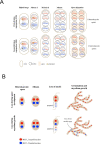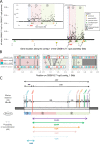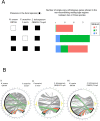Stepwise recombination suppression around the mating-type locus in an ascomycete fungus with self-fertile spores
- PMID: 36763677
- PMCID: PMC9949647
- DOI: 10.1371/journal.pgen.1010347
Stepwise recombination suppression around the mating-type locus in an ascomycete fungus with self-fertile spores
Abstract
Recombination is often suppressed at sex-determining loci in plants and animals, and at self-incompatibility or mating-type loci in plants and fungi. In fungal ascomycetes, recombination suppression around the mating-type locus is associated with pseudo-homothallism, i.e. the production of self-fertile dikaryotic sexual spores carrying the two opposite mating types. This has been well studied in two species complexes from different families of Sordariales: Podospora anserina and Neurospora tetrasperma. However, it is unclear whether this intriguing association holds in other species. We show here that Schizothecium tetrasporum, a fungus from a third family in the order Sordariales, also produces mostly self-fertile dikaryotic spores carrying the two opposite mating types. This was due to a high frequency of second meiotic division segregation at the mating-type locus, indicating the occurrence of a single and systematic crossing-over event between the mating-type locus and the centromere, as in P. anserina. The mating-type locus has the typical Sordariales organization, plus a MAT1-1-1 pseudogene in the MAT1-2 haplotype. High-quality genome assemblies of opposite mating types and segregation analyses revealed a suppression of recombination in a region of 1.47 Mb around the mating-type locus. We detected three evolutionary strata, indicating a stepwise extension of recombination suppression. The three strata displayed no rearrangement or transposable element accumulation but gene losses and gene disruptions were present, and precisely at the strata margins. Our findings indicate a convergent evolution of self-fertile dikaryotic sexual spores across multiple ascomycete fungi. The particular pattern of meiotic segregation at the mating-type locus was associated with recombination suppression around this locus, that had extended stepwise. This association between pseudo-homothallism and recombination suppression across lineages and the presence of gene disruption at the strata limits are consistent with a recently proposed mechanism of sheltering deleterious alleles to explain stepwise recombination suppression.
Copyright: This is an open access article, free of all copyright, and may be freely reproduced, distributed, transmitted, modified, built upon, or otherwise used by anyone for any lawful purpose. The work is made available under the Creative Commons CC0 public domain dedication.
Conflict of interest statement
The authors have no competing interests.
Figures






Similar articles
-
Recombination suppression and evolutionary strata around mating-type loci in fungi: documenting patterns and understanding evolutionary and mechanistic causes.New Phytol. 2021 Mar;229(5):2470-2491. doi: 10.1111/nph.17039. Epub 2020 Dec 1. New Phytol. 2021. PMID: 33113229 Free PMC article. Review.
-
Size Variation of the Nonrecombining Region on the Mating-Type Chromosomes in the Fungal Podospora anserina Species Complex.Mol Biol Evol. 2021 May 19;38(6):2475-2492. doi: 10.1093/molbev/msab040. Mol Biol Evol. 2021. PMID: 33555341 Free PMC article.
-
Diverse programs of ascus development in pseudohomothallic species of Neurospora, Gelasinospora, and Podospora.Dev Genet. 1994;15(1):104-18. doi: 10.1002/dvg.1020150111. Dev Genet. 1994. PMID: 8187347
-
Unidirectional mating-type switching is underpinned by a conserved MAT1 locus architecture.Fungal Genet Biol. 2024 Feb;170:103859. doi: 10.1016/j.fgb.2023.103859. Epub 2023 Dec 17. Fungal Genet Biol. 2024. PMID: 38114017
-
Fungal Sex: The Ascomycota.Microbiol Spectr. 2016 Oct;4(5). doi: 10.1128/microbiolspec.FUNK-0005-2016. Microbiol Spectr. 2016. PMID: 27763253 Review.
Cited by
-
Dynamics of transposable element accumulation in the non-recombining regions of mating-type chromosomes in anther-smut fungi.Nat Commun. 2023 Sep 14;14(1):5692. doi: 10.1038/s41467-023-41413-4. Nat Commun. 2023. PMID: 37709766 Free PMC article.
-
An Inversion Polymorphism Under Balancing Selection, Involving Giant Mobile Elements, in an Invasive Fungal Pathogen.Mol Biol Evol. 2025 Feb 3;42(2):msaf026. doi: 10.1093/molbev/msaf026. Mol Biol Evol. 2025. PMID: 39907064 Free PMC article.
-
The Sordariomycetes: an expanding resource with Big Data for mining in evolutionary genomics and transcriptomics.Front Fungal Biol. 2023 Jun 30;4:1214537. doi: 10.3389/ffunb.2023.1214537. eCollection 2023. Front Fungal Biol. 2023. PMID: 37746130 Free PMC article. Review.
-
Genome biology and evolution of mating-type loci in four cereal rust fungi.PLoS Genet. 2024 Mar 18;20(3):e1011207. doi: 10.1371/journal.pgen.1011207. eCollection 2024 Mar. PLoS Genet. 2024. PMID: 38498573 Free PMC article.
-
Genetic differentiation in the MAT-proximal region is not sufficient for suppressing recombination in Podospora anserina.G3 (Bethesda). 2025 Apr 17;15(4):jkaf015. doi: 10.1093/g3journal/jkaf015. G3 (Bethesda). 2025. PMID: 39849944 Free PMC article.
References
-
- Muller HJ. Some genetic aspects of sex. Am Nat. 1932. Mar 1;66(703):118–38.
-
- Hill WG, Robertson A. The effect of linkage on limits to artificial selection. Genet Res. 1966. Dec;8(3):269–94. - PubMed
-
- Hartmann FE, Duhamel M, Carpentier F, Hood ME, Foulongne-Oriol M, Silar P, et al.. Recombination suppression and evolutionary strata around mating-type loci in fungi: documenting patterns and understanding evolutionary and mechanistic causes. New Phytol. 2021;229(5):2470–91. doi: 10.1111/nph.17039 - DOI - PMC - PubMed
Publication types
MeSH terms
LinkOut - more resources
Full Text Sources
Miscellaneous

